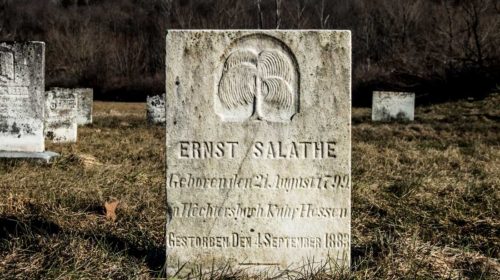A small group of German immigrants settled along the Newfoundland Road near the Wallenpaupack Creek around 1828, forming the village of Newfoundland. In 1837, they organized a Moravian Congregation and built the first church in the community, the Hoffenstal, or Hopedale Moravian Church. The graveyard was located on church land on the bank of the meandering creek. The original cemetery was enclosed by a stone wall, probably to keep out the wandering livestock of the village. Because of the high water table near the creek, graves had to be relatively shallow. Stones were placed on top of the caskets for added weight so they didn’t rise during the frequent spring floods.
Burials in the cemetery, which the Moravians called God’s Acre, were made according to the beliefs and funeral practices of the church. Men and women were buried chronologically, in the order in which they left their earthly life. There were no fancy headstones, monuments or statues to distinguish one person from another. Flat grave markers hugged the ground because they believed that everyone is equal in death.
Music was important to the Congregation, and trombones were the primary musical instrument used for celebrations—and a funeral was a celebration. A trombone choir was formed in the mid-1800s, and they played hymns as the dead were laid to rest.
At first the tombstones were inscribed in German, but by the mid-1800s the pastors conducted services in both German and English and the later tombstones were inscribed in English. The earliest birthdate recorded is that of John Straup, born in 1794, and the earliest death date is that of Margaret Ann Batzel, age 11, who died in 1821. The latest burial in the cemetery occurred in 1926. The cemetery sustained damage over the years from flooding, and this may be one reason the Church established the new Hopedale Moravian Cemetery on higher ground.
